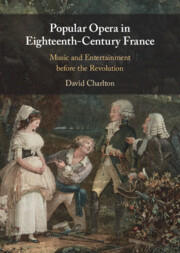Book contents
- Popular Opera in Eighteenth-Century France
- Popular Opera in Eighteenth-Century France
- Copyright page
- Dedication
- Epigraph
- Contents
- Illustrations
- Tables
- Examples
- Preface
- Acknowledgements
- Notes on the Text
- Abbreviations
- 1 Introduction
- 2 Music and Spoken Theatre
- 3 Music in Gherardi’s Company
- 4 Singing and Acting at Home
- 5 Opéra-comique en vaudevilles
- 6 Experiences of Popular Theatre
- 7 Comic and Serious Themes
- 8 Performance as History
- 9 Musical Expansion
- 10 Italian Inroads: The King’s Company
- 11 Six Methods of Synthesis
- 12 A ‘Musico-Dramatic Art’
- 13 Conclusions
- Stage Works Cited
- Bibliography
- Index
9 - Musical Expansion
Published online by Cambridge University Press: 09 December 2021
- Popular Opera in Eighteenth-Century France
- Popular Opera in Eighteenth-Century France
- Copyright page
- Dedication
- Epigraph
- Contents
- Illustrations
- Tables
- Examples
- Preface
- Acknowledgements
- Notes on the Text
- Abbreviations
- 1 Introduction
- 2 Music and Spoken Theatre
- 3 Music in Gherardi’s Company
- 4 Singing and Acting at Home
- 5 Opéra-comique en vaudevilles
- 6 Experiences of Popular Theatre
- 7 Comic and Serious Themes
- 8 Performance as History
- 9 Musical Expansion
- 10 Italian Inroads: The King’s Company
- 11 Six Methods of Synthesis
- 12 A ‘Musico-Dramatic Art’
- 13 Conclusions
- Stage Works Cited
- Bibliography
- Index
Summary
Chapter 9 documents the varied dramatic roles given to newly written music in popular opera before the 1750s; it also illustrates exceptional and virtuosic vocal music that was increasingly brought in. An initial overview names fifteen Fair theatre composers, including Elisabeth Jacquet de La Guerre, then documents musical commissions made during the first period (1714 to 1718) such as cantatas and set pieces. Louis de Lacoste’s musical depiction of the Prince’s mental disturbance in La Princesse de Carizme is explained. ‘Corrette and Modern Dance’ turns to innovations in the 1730s, the era of enthusiasm for dance. Corrette’s ‘concertos comiques’, Italian in inspiration, were sometimes linked structurally with specific opéras-comiques, whether through dance sequences or musical connections with recurring vaudevilles. ‘Beyond vaudevilles’ focuses on the continually expanding range of borrowed music. ‘Showpiece’ vaudevilles requiring vocal dexterity are compared and quoted, their origins in recent dances by Mouret, Blamont, Rebel and Francœur; but Favart also made vocal pieces from keyboard music by Couperin and an instrumental menuet by Derochet, whose lengths exceeded 100 bars. In Les Nymphes de Diane Favart treated vaudevilles as a heterogeneous musical collage; this mock-pastoral incorporated quasi-operatic group scenes.
- Type
- Chapter
- Information
- Popular Opera in Eighteenth-Century FranceMusic and Entertainment before the Revolution, pp. 208 - 235Publisher: Cambridge University PressPrint publication year: 2021

